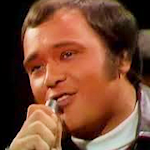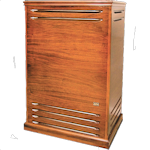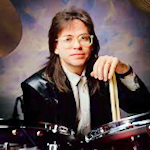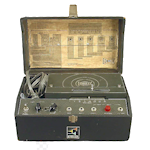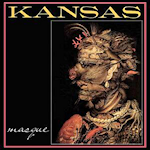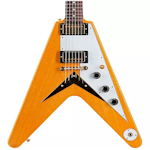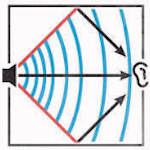
Reverb, short for reverberation, is the effect of sound reflecting off surfaces in an environment, creating a sense of space and depth. The invention and development of reverb as an audio effect in recording and electric musical instruments is a fascinating journey that spans decades and involves numerous technological advancements. Let's take a look at the history of reverb, along with some examples of its use.
Early Beginnings
Natural Reverb
Before electronic reverb units were invented, early recording engineers and musicians utilized natural reverb. Recording in spaces with desirable acoustics, such as concert halls and churches, allowed them to capture the natural reverberation of the environment.
"Bridge Over Troubled Water" by Simon & Garfunkel (1970) Recorded in Columbia's 30th Street Studio in New York, known for its natural reverberation, the title track of this album features lush, natural reverb that enhances its grand, emotional impact.
Chamber Reverb
One of the earliest artificial reverb methods was the use of echo chambers. These were specially designed rooms with reflective surfaces where a sound source would be played through a speaker and then re-recorded with the natural reverb created in the room. The Abbey Road Studios in London famously used echo chambers in their recordings during the 1950s and 1960s.
"Good Vibrations" by The Beach Boys (1966) The Beach Boys utilized Capitol Studios' echo chambers to create a rich, immersive sound. Chamber reverb added a unique spatial dimension to their complex vocal harmonies and instrumentation.
Plate Reverb
In the late 1950s, the EMT 140 plate reverb was introduced by Elektro-Mess-Technik (EMT). This device used a large metal plate suspended in a frame. Sound was sent to the plate through a transducer, causing it to vibrate. These vibrations were then picked up by contact microphones attached to the plate, creating a reverb effect. Plate reverbs became popular due to their lush and smooth sound, and they were more practical than using large echo chambers.
"When the Levee Breaks" by Led Zeppelin (1971) The iconic drum sound on this track was achieved using an EMT 140 plate reverb. The dense and smooth reverb contributes to the track's powerful, cavernous feel.
Spring Reverb
In 1939, Laurens Hammond, inventor of the Hammond organ, patented the spring reverb unit, a device that would become a standard feature in many electric musical instruments and amplifiers. The spring reverb worked by sending an audio signal through one or more metal springs, which would vibrate in response. These vibrations were then converted back into an audio signal, creating a reverberation effect.
The spring reverb unit offered several advantages:
- Compact Size: Unlike large echo chambers or plate reverb units, the spring reverb was relatively small and could be easily integrated into amplifiers and other equipment.
- Affordability: Spring reverb units were less expensive to produce than other types of reverb, making them accessible to a broader range of musicians and engineers.
- Unique Sound: The characteristic sound of spring reverb, with its distinctive "boingy" quality, became a defining feature of many recordings, particularly in genres like surf rock and early rock and roll.
Spring reverb became a popular choice, especially in guitar amplifiers. Leo Fender's use of spring reverb in the Fender Twin Reverb amplifier is but one notable example.
"Misirlou" by Dick Dale (1962) A surf rock classic, "Misirlou" showcases spring reverb's distinctive effect, integral to the genre's energetic and reverberant guitar sound.
"Pipeline" by The Chantays (1963) Another surf rock staple, "Pipeline" features the distinctive "boingy" sound of spring reverb, which was a hallmark of the genre.
The use of spring reverb in guitar amplifiers gave surf rock its characteristic spacious and vibrant sound.
Keyboardist Jon Lord, of the rock group Deep Purple, was known to rock his Hammond B-3 organ during performances in order to disrupt the springs in its reverb tank into making distorted crashing sounds.
Digital Reverb
The advent of digital technology in the 1970s and 1980s revolutionized reverb effects. Digital reverb units use algorithms to simulate the reflections of sound in different environments. This allowed for a much greater variety of reverb types and settings, including the simulation of rooms, halls, plates, and more.
One of the earliest digital reverb units was the EMT 250, introduced in 1976. It was expensive and bulky but set the stage for more affordable and practical units that followed. The Lexicon 224, released in 1978, became particularly influential, offering high-quality digital reverb that became a standard in recording studios.
"Thriller" by Michael Jackson (1982) The use of digital reverb on this iconic album, particularly the Lexicon 224, helped create the spacious, polished sound that defined many of its tracks, including the title track "Thriller."
"Let's Dance" by David Bowie (1983) Produced by Nile Rodgers, this track features the Lexicon 224 digital reverb, providing a polished and expansive sound that was characteristic of 1980s pop music.
Software Reverb
With the rise of computer-based recording in the 1990s and 2000s, software reverb plugins became common. These plugins emulate both classic hardware reverbs and entirely new reverb algorithms. They offer flexibility and ease of use, allowing musicians and engineers to apply reverb effects directly within digital audio workstations (DAWs).
"Bury a Friend" by Billie Eilish (2019) Modern software reverb plugins, such as Valhalla VintageVerb, are used extensively in Billie Eilish's music. The reverb effects contribute to the eerie, atmospheric quality of her sound.
Shimmer Reverb
Shimmer reverb is a modern reverb effect that adds an ethereal, otherworldly quality to sound by incorporating pitch-shifted reflections. This effect is often used in ambient and atmospheric music to create a sense of vastness and depth. Shimmer reverb works by combining traditional reverb with an octave-up pitch shift on the reverb tail, resulting in a lush, sparkling sound.
Shimmer reverb was popularized by ambient music pioneers like Brian Eno and Daniel Lanois in the 1980s. They used the effect extensively in their productions to add a celestial quality to their soundscapes. Eno's work on albums such as "Apollo: Atmospheres and Soundtracks" and U2's "The Joshua Tree," co-produced with Lanois, are notable examples of early shimmer reverb use.
Shimmer reverb combines a few key processes:
- Traditional Reverb: Provides the initial spacious and ambient quality.
- Pitch Shifting: Adds an octave-up (or sometimes other intervals) pitch shift to the reverb tail.
- Feedback Loop: The pitch-shifted reverb tail is fed back into the reverb, creating cascading, harmonically rich overtones.
"Deep Blue Day" by Brian Eno (1983) From the album "Apollo: Atmospheres and Soundtracks," this track showcases the shimmer reverb effect, contributing to its dreamy, floating ambiance.
"With or Without You" by U2 (1987) Produced by Brian Eno and Daniel Lanois, this track features subtle use of shimmer reverb on The Edge's guitar parts, adding a haunting, ethereal quality to the song's atmosphere.
"You Won't Know Where You Stand" by Aquilo (2018) This track uses shimmer reverb on the vocals and synths to create a spacious and uplifting sound that enhances the emotional impact of the music.
Modern Use and Popularity
Shimmer reverb has become more accessible with the advent of digital signal processing and software plugins. Today, many reverb plugins offer shimmer effects, allowing musicians and producers to easily incorporate this sound into their productions. Some popular shimmer reverb plugins and units include:
- Eventide Blackhole: Known for its vast, modulating reverb sounds, including shimmer effects.
- Valhalla Shimmer: A dedicated plugin for creating shimmering reverbs with extensive control over pitch shifting and feedback.
- Strymon BigSky: A hardware reverb pedal favored by guitarists, which includes a shimmer reverb mode among its many features.
Modern Developments
Today, reverb continues to evolve with advancements in digital signal processing and machine learning.
Convolution reverb, which uses impulse responses recorded from real spaces to create highly realistic reverb effects, has become popular. This technology allows users to apply the acoustic characteristics of famous concert halls, studios, and other spaces to their recordings.
"Viva La Vida" by Coldplay (2008) Utilizing convolution reverb, this track incorporates the acoustics of real spaces, adding depth and realism to the orchestral and vocal elements. Convolution reverb allowed the producers to replicate the sound of famous recording spaces.
Impact on Music and Recording
The development of reverb has had a profound impact on music and audio production. Reverb effects help create a sense of space and depth, enhancing the emotional and aesthetic qualities of music. Different types of reverb are used creatively across genres, from the lush, expansive sounds in ambient music to the tight, controlled reverb in pop and rock recordings.
Rock and Roll
- The use of spring reverb in guitar amplifiers by artists like The Ventures and The Shadows helped define the rock and roll sound of the 1960s.
Pop and Electronic
- Digital reverb units like the Lexicon 224 were essential in shaping the sounds of pop and electronic music in the 1980s and 1990s, with artists like Madonna and Depeche Mode utilizing these effects.
Hip-Hop and R&B
- Producers in hip-hop and R&B often use software reverb plugins to add depth and space to vocals and beats. For example, the lush reverbs in Frank Ocean's "Blonde" (2016) album create a dreamlike, intimate atmosphere.
Conclusion
Reverb technology has evolved significantly over the decades, from natural and chamber reverb to plate, spring, digital, convolution, and software reverb. Each advancement has enabled artists and producers to explore new sonic landscapes and has contributed to the distinct sounds of various musical eras and genres. By understanding the application of these technologies in popular music, we can appreciate the profound impact of reverb on the way we experience recorded sound.

